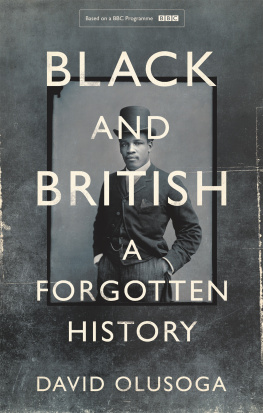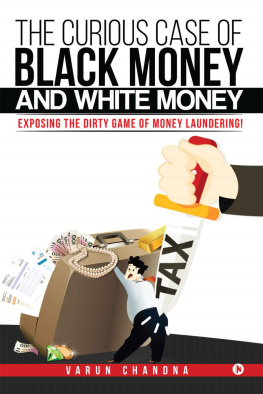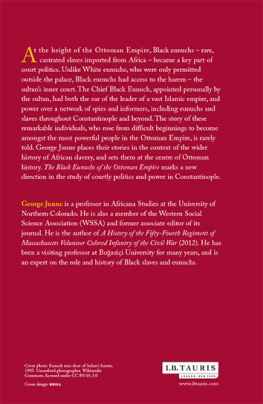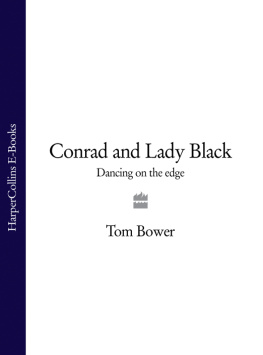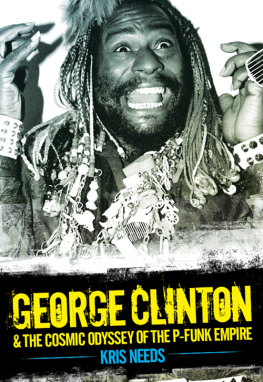ROBBER BARON
ROBBER BARON
LORD BLACK OF CROSSHARBOUR
GEORGE TOMBS

Copyright George Tombs, 2007
Published by ECW PRESS
2120 Queen Street East, Suite 200, Toronto, Ontario, Canada M4E 1E2
All rights reserved. No part of this publication may be reproduced, stored in a retrieval system, or transmitted in any form by any process electronic, mechanical, photocopying, recording, or otherwise without the prior written permission of the copyright owners and ECW PRESS.
LIBRARY AND ARCHIVES CANADA CATALOGUING IN PUBLICATION
Tombs, George
Robber Baron: Lord Black of Crossharbour / George Tombs.
ISBN 978-1-55022-806-9
1. Black, Conrad. 2. Publishers and publishingCanadaBiography.
1. Title.
PN4913.B56T64 2007 070.5092 C2007-904134-5
Front cover photo: Reuters / John Gress
Back cover photo: The Canadian Press / Dave Chidley
Cover and text design: Tania Craan
Typesetting: Gail Nina
Printed by Thomson-Shore
DISTRIBUTION
CANADA: Jaguar Book Group, 100 Armstrong Avenue, Georgetown, ON, L7G 5S4
UNITED STATES: Independent Publishers Group, 814 North Franklin Street, Chicago, Illinois 60610
PRINTED AND BOUND IN THE UNITED STATES

TABLE OF CONTENTS

The Canadian Press/The Globe and Mail/Fred Lum
CHAPTER ONE
ENTERING THE LABYRINTH
IT WAS A DARK, WINTRY DAY in December 2006, with sleek, black leafless trees silhouetted against low clouds and wet snow fading on the ground. Three months before the start of Conrad Blacks trial in Chicago on fourteen counts of criminal fraud, breaches of fiduciary duty, mail and wire fraud and racketeering, I had flown from Montreal to Toronto for the day. Black Baron Black of Crossharbour had given me a two-hour appointment at his Georgian mansion, in the exclusive Bridle Path area, to discuss a new edition of my book about him.
I took a cab from the airport. The closer we got to Blacks house, the more excited my Sikh driver became. Oh my goodness! he said as the ranch bungalows on small lots gave way to the gloomy neo-Gothic and garish Mediterranean suburban palaces of Torontos arrivistes. So many rich people live around here. Look at these houses! There must be so many gardeners working here in the spring. Tell me, sir, what do you do for a living? You are a university professor that is a very well-paid job. So, this is the house we are going to? Oh my goodness, we have to get out at the gate and announce through the radio intercom who we are. Is your friend also a university professor?
Sprawling 26 Park Lane Circle is a Can.$20-million brick mansion, with a stately portico entrance and Palladian windows, standing back from the road on an eleven-acre estate. Black sometimes jokingly referred to it as his cottage. It was his parents home, the place where he grew up. In the 1980s, after Black inherited the place, he hired New York-based celebrity architect Thierry Despont whose clients included Microsoft billionaire Bill Gates and completely rebuilt the mansion, gutting whole sections and adding an indoor pool and library. Black pays more than Can.$70,000 in annual property taxes.
As we entered the gate, the driveway curved rightward down past the entrance of the house, then looped back again, in front of the main door. Even in the first week of December, ripe green apples still clung to the branches of two huge trees. We came round an enormous weeping willow, then swept in front of the entrance.
Werner, the sixty-five-year-old German butler dressed all in white, stood at the door. With his stern, obsequious manner, he ushered me to the cloak room, off to the right as we entered, where he took my leather jacket and hung it up. He then led me back through the two-storey entry hall with barrel-vaulted ceiling, where portraits of the Prince Regent (the future George IV) and Napoleon were displayed. To my left was the stairway, where Conrad Blacks father, George, had fallen over the banister upstairs in 1976 and come crashing down onto the main floor. That was the day father told son, Life is hell, most people are bastards, and everything is bullshit.
Everything in the house has been changed, one of Conrad Blacks cousins told me, except the entrance and the stair where Uncle George fell to his death. Even Black once wrote he wasnt sure whether his fathers death was voluntary. It was a touchy subject for him. For decades, George Blacks depression and his sudden death had hung like a cloud over his son. Conrad had preserved the entrance and stairwell intact it seemed a grim memorial to his father.
By the time I got there, 26 Park Lane Circle had become a gilded cage for Black. In the lead-up to his criminal trial, he had to post a $21-million bondhis hometown of Toronto or his $35.5-million winter ocean-front retreat in Palm Beach without first getting court approval.
Along the stairwell, I could see an enormous print of Rome from the early nineteenth century, showing St. Peters to the left, which Black had collected as a souvenir from a landlady during his early years in London. It must have been about ten to twelve feet long. I remembered seeing it at Blacks 13.1-million mansion in Cottesmore Gardens, London, when we met there in 2002 he was forced to sell that property three years later, when his business empire had begun to disintegrate. To my right was the main living room, with a series of French doors overlooking the park. This park slopes downward onto expansive terraces, gardens and into a forest, and must be uneven terrain for garden parties, although it is a paradise for racoons.
Werner led me past a stairwell to the basement, the walls covered with handwritten correspondence in gold frames between President Franklin Roosevelt and his cousin and probable mistress Daisy Suckley. I remembered some of the letters from my 2003 visits to Blacks executive suite at Hollin ger International on Fifth Avenue in New York, just before he was turfed out of his job there. There were also some framed letters signed by Abraham Lincoln.
I had entered the inner sanctum of Blacks private mythology. He has the habit of fusing his personality with his political heroes, papering his walls with rich symbols of power, as if some of their magnificence would rub off on him. He has a dreamy, expansive, blistering nature blowing a fortune on fantastic decor all around him, drawing analogies between himself and colossal, larger-than-life figures (as a way, I thought, of drowning his own deep-seated insecurity).
Werner showed me to the sitting room, with some green-and-cream-striped Empire chairs I recognized from the Cottes -more Gardens mansion. A lot of things had moved around in the last couple years. There were a few million dollars worth of Canadian paintings on the walls, cluttered like postage stamps. One was by Jean Paul Lemieux, another was a nondescript painting by Robert Pilot showing a church in Quebec, and there was a Maurice Cullen. A painting by A. Y. Jackson showed a village chapel in Quebecs Charlevoix county in winter, with some logs floating in a river in the foreground. On a low coffee table were a few books about platinum jewels and a recent book by Barbara Amiels former husband, George Jonas. Here I waited.
I first met Conrad Black and Barbara Amiel in June 1993 when I worked at the Southam-owned daily the Montreal
Next page




